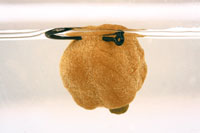Artificial Mixers
One of the main advantages of an artificial mixer is that it will remain very buoyant. Conversely, a real one will take on water and sink further. It’s better to retain the buoyancy because fish need to suck harder to get it into their mouths. Thus, they are more likely to take the bait properly and hook themselves.
Without doubt, the best of the artificial mixers are the relatively new counterweighted baits, each of which features a hole on one side for a split shot. With the hook on the opposite side, the heavier split shot forces the mixer to sit on the bottom with the hook top side up out of the water and out of sight of the fish – which should mean you get more takes. The hook is side hooked into the top side, but only after being placed onto a long hair (see sequence).
The early versions of these were too buoyant, but the latest ones we’ve seen do sit well down in the water to mimic the loose feed. In truth, it’s not all that easy to set these up correctly. Many anglers have tried them only to find that the mixer turns over on its side and the hook is visible to the fish. A size 10 hook is the right one for this rig, but for it to work it’s crucial that the hook is lighter than the shot in the bottom.
Lighter-gauged wire hooks such as the Drennan Carbon Specimen, the Fox Series 2 and the Drennan Specimen Barbless are needed. The other trick is not to use too stiff a hooklength line (a stiff hook link will tip the mixer over). A soft and supple hooklength (something like an 8lb Drennan Double Strength is perfect) should allow the mixer to sit perfectly in the water. To get it right, test it in the margins before casting out.
As you will see from the pictures, because you get an offset hook when using the knotless knot the line actually lifts off the mixer when mounted correctly and there is no line touching the water near to the mixer. However, if the hook comes out, you still have a secure hair connection and there’s no chance of leaving the bait out there when you reel in. You know it makes sense!
How To Hook The Counterbalanced Mixer
 |
Step 15
Pull the hooklength knot into the mixer so that the hook sits proud. |
|
 |
Step 16
The imitation mixer should sit like this, with the hook and hooklength out of sight of the fish. |
|

























